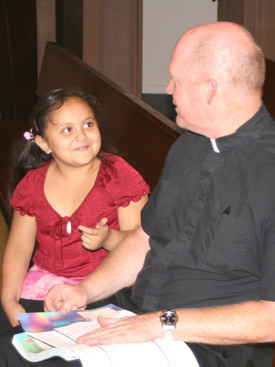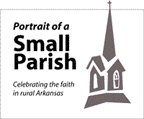

DUMAS -- Holy Child of Jesus Church in Dumas is a long way for two men who met at a pilgrimage in Mexico, to see one another again, but meet they did.
Father Phillip Reaves, who comes from St. Mark Church in Monticello to celebrate a bilingual Mass on Sunday afternoons, recalls going on the pilgrimage in Mexico more than five years ago, where, as he said, because he was the only person not from Mexico, he "stuck out like a sore thumb."
The first time he walked into Holy Child, he heard someone call, "Padre Felipe."
It was one of the fellow pilgrims.
"We have a group of guys who come in March and work in the cotton fields and cotton gin and leave when all the cotton is out of the fields," Father Reaves said one recent Sunday after Mass. "They may have gone back to Mexico for the winter. It is interesting to see them."
This Sunday, many of the men were absent because, due to a break in the weather, they were finally able to get back into the fields to work.
Like with many small town parishes, attendance at Mass has dwindled.
Longtime parishioner Charlotte Schexnayder, a former state representative and publisher of the Dumas Clarion, recalls when the church would fill up for holiday Masses. That recent Sunday, 10 people attended the bilingual Mass. Scripture readings alternated between Spanish and English, as did parts of the Mass. Sometimes only the Spanish-speaking members responded; other times only the English-speaking members responded. Father Reaves gave his bilingual sermon.
Click here |
More Hispanics attended the mission as well, but something happened and many stopped attending before Father Reaves arrived.
Schexnayder is one of the faithful who attend regularly, said bilingual Masses have caused attendance to drop sharply.
"It is just a handful of us now," she said of the original parishioners.
Schexnayder has been at Holy Child through good times and bad times, watching it, like a family member, grow, new buildings rise, the number of faithful increase and decrease through the years, yet she continues going to Mass every weekend.
She has great memories of the church through the years, as do a lot of other Catholics who live in the area but are now attending Mass elsewhere, of dinners that brought them together, fundraisers, work to build the church and education building, she said.
Holy Child is rich in ethnic diversity, according to Schexnayder, who wrote the church's history. At one point, the parish had 40 Catholic families, including black, Mexican, Nigerian, Polish, Canadian, Filipino and Honduran.
Services for Hispanic families started in 1994 with monthly Mass. Weekly Spanish Masses followed, celebrated after the Mass in English. Many of the Hispanics were from the Mexican state of Michoacan, some from other Mexican states and some from Central America.
María de los Angeles Meja said she has been attending Holy Child seven years with her family. They arrived in the Dumas area approximately 12 years ago. Although she likes the bilingual Masses, she said in Spanish, what she does not like is that very few people attend.
"I would like to see more people attending, more activities, more like family, with a choir, but we have nothing," she said.
Her husband and son usually attend Mass with her and her daughter Karla, but this Sunday they were out working on a farm, she said.
The brick church was dedicated in 1967.
Long before that, Catholics first met at the home of Estelle and Arthur L. Mayer, where for three years, Sunday Mass was celebrated, according to Schexnayder.
Each Sunday, men would arrive early enough to move furniture into other rooms and the attic of the residence and set up folding chairs in the living room, she said. After Mass, the chairs and altar were moved and the furniture returned to its original location.
According to Arkansas Catholic archives, there were 18 families with 53 Catholics living in the Dumas area when fundraising started.
"When we came here around 1954, I think there were maybe a dozen Catholics here but as we started to build the church more people came and we identified more people," Schexnayder said. "We had a nice congregation of 50 or more at times, we filled up this church on holidays."
Groundbreaking for the church was held Nov. 18, 1966. While the church was being constructed, Schexnayder said, parishioners attended Mass at the local funeral home chapel.
"One Sunday, a minor earthquake rattled the roof in the midst of a prayer," Schexnayder recalled. "Everyone was even more religious."
Please read our Comments Policy before posting.
Article comments powered by Disqus Don’t let misconceptions cause faith to waver
Don’t let misconceptions cause faith to waver
 Seniors, whatever storms may come, Jesus will be there
Seniors, whatever storms may come, Jesus will be there
 Studio 3:16 offers new approach to teaching religion
Studio 3:16 offers new approach to teaching religion
 After three decades, NLR principal plans to retire
After three decades, NLR principal plans to retire
 CHS athlete overcomes odds to reach collegiate goal
CHS athlete overcomes odds to reach collegiate goal
 St. Joseph a model of solidarity with immigrants
St. Joseph a model of solidarity with immigrants
 Two gifts after Jesus’ death: Virgin Mary and Eucharist
Two gifts after Jesus’ death: Virgin Mary and Eucharist
 Why we have an altar, and not just a communion table
Why we have an altar, and not just a communion table
 Pope: Wars should be resolved through nonviolence
Pope: Wars should be resolved through nonviolence
 Living relationship with Jesus Christ in the Eucharist
Living relationship with Jesus Christ in the Eucharist